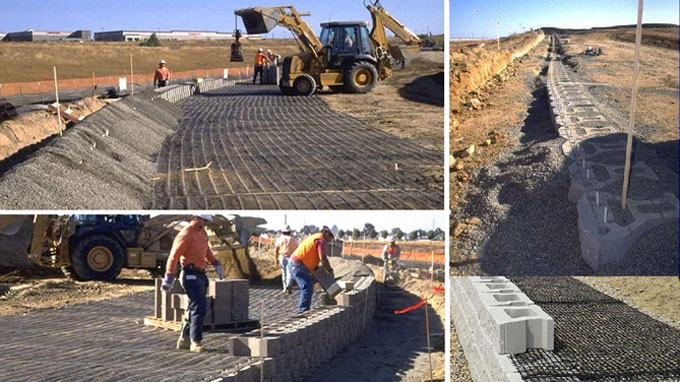
How to build Reinforced Retaining Wall using Geogrids

Today, there are many modern technologies used for advanced construction. In ground construction, the use of geogrids is getting more and more common. Today, we will talk about construction a retaining wall using geogrid.
What is geogrid
Geogrid is one type of geosynthetic material used for reinforcing soil and similar material. It is a basically a flexible wiry mesh made out of synthetic materials. A properly made geogrid is very well capable of soil retention and slope stabilization.
Geogrids are available in many shapes and sizes, and they can be made from a variety of materials as well. However, as the strength and other capabilities vary a lot depending upon those factors directly, it is mandatory to check your needs and test out the geogrid before you utilize it in your construction.
Why are geogrids needed
Compared to soils, geogrids are much stronger in tension. And that is the very reason why they are used in reinforcing retaining walls, sub bases or sub soils below ground construction such as highways or large structure footings. This allows the force coming from above to spread over a much wider area, and to hold the soil together as the downward force tried to expand the soil sideways.
A retaining wall cannot get very tall, but sometimes you need the height to get the job done. In fact, no retaining wall can be any taller than 4 feet. If you try to go above that, you will need to use a geogrid to reinforce the retaining wall. With proper design and good quality geogrid, you can build retaining walls as high as 30 to 40 feet!
To be clear, when the weight of the retaining wall alone isn?t good enough to hold the soil loads in, you need the help of a geogrid to reinforce the retaining wall. This will provide the additional soil reinforcement necessary to stabilize the wall. Not only that, the geogrid reinforcement will make sure your retaining wall is long-lasting as well as functional and attractive.
How to construct geogrid reinforcements
A. Excavation
The soil area needs to get excavated before you install geogrid reinforcements.
After taking proper precautions, begin excavating the ground soil from the area by digging a trench there. The size of this trench will depend upon the following:
1. Maximum embedment length of the geogrid
2. Thickness of the leveling pad
3. Burial depth of the wall
In any case, you have to make sure at least half a foot of the retaining wall is steadily buried under the soil or else it won?t stand. The same size, 6?, goes for the minimum width of the leveling pad.
B. Preparing the geogrid
Geogrids come in rolls. Begin cutting the roll to the length you need, which would be the embedment depth of the geogrid. Make sure you know whether to cut it biaxially or uniaxially, as per the manufacturer?s specifications. Commonly the geogrids are placed perpendicular to the wall face, but it?s possible to do it otherwise as per the needs.
C. Installing the geogrid
Once the cutting is complete, the geogrid can be laid to use. Roll the geogrid according to specifications, and do make sure that it is pulled past the wall face a little. Then pin the whole thing in place by placing the next course of block on top of it.
When the rolling is complete for the entire wall, check the offsets. They should be correctly lined up, and the geogrid should be properly installed. Once the geogrid is in place and is lined up, cut off any extra grid that?s showing beneath. Remove any remaining stuff with a razor and torch.
D. Securing the geogrid
Once it is installed, you need to secure it in place. Pull taunt to remove all slack and loose folds, also stake or otherwise fix the grid in position. This will pin the geogrid in place securely and prevent in movement as the next phase, backfilling is going on.
E. Backfilling
Now it is time to fill in the soil on the geogrid. Use 8 inches or less lifts to do the backfilling. Note that you can?t perform any kind of compaction directly on top of the geogrid. If you do, the geogrid will get damaged and its integrity may get compromised. For the same reason, make sure you keep all the heavy equipment away from the edge of the wall ? at least 3 feet away.
If you?re planning to drive on the backfill, you will need at least 6 inches of fill, compacted naturally, before the soil is ready for driving over the stretch.
Conclusion
Retaining walls are used for a variety of purposes, but the most prominent use of it comes as holding back the blocks of soil that is unstable or may get unstable over time or specific use. They are also used to prevent erosion of land due to natural reasons ? though in this case they should be only used in situations where you can?t use a patch of forest to hold the land together, or simply don?t have the time.
Whatever the purpose of it, a retaining wall is useless if it can?t do its job properly. Sometimes, you need to place geogrid reinforcements in a retaining wall to make it stable and long-lasting. A horizontally layered geogrid will make sure the wall has enough strength to hold back the soil mass, and prevent collapse or erosion. The material choice of the geogrid heavily influences this.

Image Courtesy: fantasticeng.com

